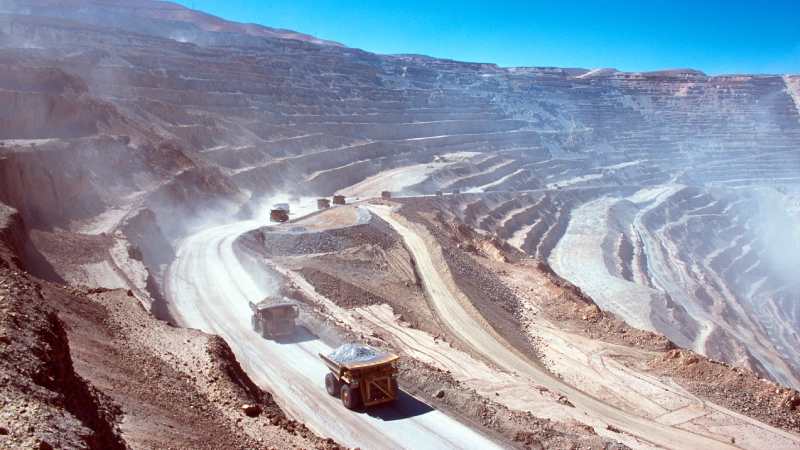Latin America has the mining potential to contribute to the global supply of several critical minerals. ECLAC data show that the region has significant reserves of lithium, copper, nickel, molybdenum, graphite, and other minerals. Chile stands out for its lithium and copper reserves, Peru for its copper and molybdenum reserves, Brazil for its lithium, graphite and rare earths reserves, and Mexico for its copper reserves.
Increased demand for minerals and metals
As the demand for AI increases around the world, so does the need for these materials. For example, the chips and other components required for AI rely on minerals such as lithium and metals such as cobalt. Semiconductor chips are primarily made of silicon, but also contain metals such as copper, gold, tin, nickel, palladium, and silver. In addition, storage devices use metals such as platinum, palladium and gold for their magnetic and conductive properties.
With this market growth, the region needs to focus on modernizing the mining industry, adopting new technologies, and improving critical infrastructure, as well as applying new technological advances such as AI and big data to improve and increase productivity. Through technological innovation, human capital development, and strengthened governance, the mining industry can not only improve its competitiveness, but also lead the way to more responsible and eco-friendly mining. To achieve this, the industry must address a number of challenges, including environmental protection, cost and productivity growth, and technological innovation.
- Environmental responsibility: The demand for minerals and metals is critical to the alternative energy sources, which will require increased mining activity. The International Council on Mining and Metals (ICMM) is leading the drive towards Nature Positive , with the goal of halting and reversing the degradation of the natural environment by 2030, and therefore innovation circularity and integrated land management as critical keys to meeting climate goals and development while protecting and restoring nature.
To balance the growing demand for AI with sustainability strategies, mining companies must take a holistic approach that integrates technological innovation, clean energy, responsible resource management, and an energy-efficient, eco-friendly critical digital infrastructure. Historically and currently, the mining industry has a significant impact on the environment, which is why AI applications are key to innovatively addressing select challenges of the mining industry.
For example, data-driven applications enable the implementation of real-time monitoring and analysis solutions through technologies such as Internet of Things (IoT) sensors and advanced data analytics, which can optimize the use of resources and reduce environmental impact. Real-time data can be used to help manage energy and water consumption, identify areas of inefficiency, and minimize waste.
- Rising costs and productivity: Mining production costs, which have increased by 30% in the last five years, and the high cost of energy in Latin America, are putting pressure on profitability for mining companies. Therefore, it is necessary to invest in technology to simplify and speed mineral extraction, improve business intelligence, promote innovation and adopt better ways of working in order to save costs and improve productivity.
Efficient transportation of mined materials is also crucial to maximizing mining productivity and minimizing costs. By optimizing transportation and logistics, mining companies can streamline their supply chains, reduce delays and improve operational efficiency. However, to support these technologies and solutions, the industry must have a robust and resilient critical infrastructure capable of handling data and processing information quickly.
The demand for technology and innovation in the mining industry has led to a growing interest in digital, making data centers essential to provide enable data-driven processes for operational continuity and the application of these new technologies, such as:
- Data analytics and storage of sensitive information for mining operations.
- Hosting software and applications.
- Operationalizing big data, machine learning and AI.
- Securing high-volume e-commerce transactions.
- Enabling easy connectivity. For example, in the case of autonomous trucks driven remotely by remote operators, which requires a large investment in high-availability communications networks.
- IT / OT convergence (Information Technology and Operational Technology).
- Digitization of operations across the entire mining value chain.
Recently, Vertiv worked with a mining company in Chile to renovate its data center equipment, with main objectives: Support and the mining company’s investment in advanced technologies by increasing power capacity with energy efficiency, redundancy and availability. A Vertiv™ Liebert® APM modular online uninterruptible power supply (UPS) with lithium-ion batteries was implemented to provide space-saving autonomy, high energy efficiency and reliable uptime for the servers and other equipment.
Overcome challenges with innovation
Vertiv understands the complexities and challenges of data center operations in the mining industry, offering effective and reliable solutions by adapting containers or prefabricated solutions to withstand the harsh conditions typical of industrial and mining environments — from corrosive elements and high humidity to saline exposure, extreme temperatures, dust, high altitudes, seismic activity, and even snow. That is why Vertiv provides a complete portfolio of systems to support mission critical applications, such as UPS, precision air conditioning equipment, racks, Geist PDU, SmartMod, or SmartCabinet, among others.
For more details on how to meet the challenges of the data center availability for the mining industry, click here.




